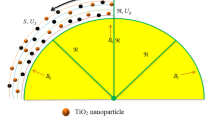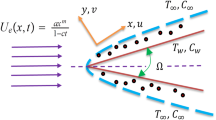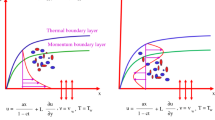Abstract
This study examines the rheological effects of a hybrid nanofluid and the swimming behavior of gyrotactic microorganisms in an unsteady flow over an expandable Riga wedge. A stagnation point region, suspended with hybrid nanofluid and microorganisms, is considered, subject to velocity slip at the boundary. The study investigates the bio-convection fluid flow phenomenon and considers the effects of chemical reaction, heat source/sink, mass suction, and activation energy. A precise similarity transformation is used to convert the governing partial differential equations into ordinary differential equations. These are then numerically solved using the shooting technique in MATLAB, specifically with the BVP4C solver. The study scrutinizes the effects of various relevant parameters on the dimensionless profiles of velocity, temperature, concentration, and microorganisms. Furthermore, the surface drag force, heat transfer rate, Sherwood number, and motile microorganism density are calculated. To validate the accuracy of the adopted numerical scheme, a tabular comparison is made between the current results and those from the literature in a limiting case. It is observed that adding Al2O3 nanoparticles decreases the fluid velocity, while adding Cu nanoparticles increases it; however, in both cases, the fluid temperature decreases. Increasing the wedge angle parameter enhances the fluid temperature and motile density. The heat transfer coefficient decreases with increasing nanoparticle concentration and wedge angle parameter, whereas the opposite behavior is observed for the Biot number.






























Similar content being viewed by others
Data Availability
No datasets were generated or analysed during the current study.
Abbreviations
- A :
-
Unsteadiness parameter
- B :
-
Constant
- Bi:
-
Biot number
- C :
-
Concentration of the fluid (kg/m3)
- C 0 :
-
Initial reference concentration (kg/m3)
- C w :
-
Concentration at the surface (kg/m3)
- c p :
-
Specific heat (J/kg K)
- C ∞ :
-
Concentration far away from the disk (kg/m3)
- d :
-
Width of the electrodes and magnets (m)
- D B :
-
Brownian diffusion coefficient (m2/s)
- D M :
-
Diffusivity of the microorganisms (m2/s)
- D T :
-
Thermophoresis diffusion coefficient (m2/s)
- E :
-
Dimensionless activation energy
- \({E}_{a}\) :
-
The activation energy (kcal/mol)
- \({\left(\frac{T}{{T}_{\infty }}\right)}^{n}exp\left(-\frac{{E}_{a}}{{K}_{B}T}\right)\) :
-
The modified Arrhenius function
- g :
-
Gravitational constant
- h f :
-
Heat transfer coefficient
- J 0 :
-
External flow rate in the electrodes
- k :
-
Thermal conductivity(W/m K)
- K r :
-
Chemical reaction rate
- Lb:
-
Bio-convection Lewis number
- M 0 :
-
Magnetic properties of the fixed magnet
- M h :
-
Modified Hartmann number
- N :
-
Microorganism density
- N 0 :
-
Initial reference motile density
- N w :
-
Microorganism density at the surface
- Nb:
-
Brownian motion parameter
- N r :
-
Buoyancy ratio factor
- Nt:
-
Thermophoresis parameter
- Nux :
-
Local Nusselt number
- n :
-
Constant
- Pe:
-
Peclet number
- Pr:
-
Prandtl number
- Q n :
-
Nonlinear thermal radiation
- q m :
-
Surface mass flux
- \({q}_{{w}_{1}}\) :
-
Surface heat transfer
- \({q}_{{w}_{2}}\) :
-
Dispersion of motile microbes
- R :
-
Radiation parameter
- R b :
-
Rayleigh number
- Rex :
-
Local Reynolds number
- s :
-
Suction/injection parameter
- Sc:
-
Schmidt number
- Shx :
-
Local Sherwood number
- T :
-
Temperature (K)
- T 0 :
-
Initial reference temperature (K)
- T R :
-
Temperature ratio parameter
- T w :
-
Temperature at the surface (K)
- u e :
-
Free stream velocity (m/s)
- u,v :
-
Velocity components of the fluid along x- and y-axes, respectively (m/s)
- \({u}_{w}\) :
-
Velocity of the Riga wedge (m/s)
- v w :
-
Velocity of the fluid through the wall (m/s)
- α * :
-
Angle of the wedge
- α h :
-
Dimensionless constant
- β :
-
Wedge angle parameter
- χ :
-
Dimensionless motile density of the fluid
- δ :
-
Constant dimension \({\left({\text{time}}\right)}^{-1}\)
- δ l :
-
Microorganism concentration difference factor
- η :
-
Similarity variable
- λ :
-
Velocity ratio parameter
- μ :
-
Dynamic viscosity
- ν :
-
Kinematic viscosity (m2/s)
- ω :
-
Mixed convection parameter
- Ω c :
-
Chemical reaction parameter
- ϕ :
-
Dimensionless concentration of the fluid
- ψ :
-
Stream function
- ρ :
-
Density of the fluid (kgm−3)
- ρ m :
-
Density of motile microorganisms (kgm−3)
- ρ p :
-
Density of nanoparticles (kgm−3)
- τ ω :
-
Shear stress
- σ* :
-
The Stefan-Boltzmann constant
- θ :
-
Dimensionless temperature of the fluid
- hnf :
-
Hybrid nanofluid
- f :
-
Base fluid
References
Hillesdon, A. J., & Pedley, J. J. (1996). Bioconvection in suspensions of oxytacticbacteria: Linear theory. Jfluid mechanics, 324, 223–259. https://doi.org/10.1017/S0022112096007902
Kuznetsov, A. V., Avramenko, A. A., & Geng, P. (2004). Analytical investigation of a falling plume caused by bioconvection of oxytactic bacteria in a fluid saturated porous medium. Int JEngineering Science, 42(5–6), 557–569. https://doi.org/10.1016/j.ijengsci.2003.08.004
Avramenko, A. A., & Kuznetsov, A. V. (2010). Bio-thermal convection caused by combined effect of swimming of oxytactic bacteria and inclined temperature gradient in a shallow fluid layer. Int J Numerical methods for Heat and Fluid flow, 20, 157–173. https://doi.org/10.1108/09615531011016939
Sheremet, M. A., & Pop, I. (2014). Thermo bioconvection in a square porous cavity filled by oxytactic microorganisms. Transport porous media, 103, 191–205. https://doi.org/10.1007/s11242-014-0297-4
Ahmed, S. E., Oztop, H. F., Mansour, M. A., & Abu-Hamdeh, N. (2010). Magnetohydrodynamic mixed thermo-bioconvection in porous cavity filled by oxytactic micro-organism. Thermal Science, 22(6B), 2711–2721. https://doi.org/10.2298/TSCI161005319A
Balla, C. S., Alluguvelli, R., Naikoti, K., & Makinde, O. D. (2020). Effect of chemical reaction on bioconvection flow in oxytactic microorganisms suspended porous cavity. J Applied and Computational Mechanics, 6(3), 653–664.
Muhammad, N. K., & Sohail, N. (2020). Theoretical treatment of bio-convective Maxwell nanofluid over an exponentially stretching sheet. Canadian Journal of Physics., 98(8), 732–741. https://doi.org/10.1139/cjp-2019-0380
Khan, M. N., Ahmed, A., Ahammad, N. A., Wang, Z., Hassan, A. M., & Elkotb, M. A. (2023). Chemotaxis bioconvection in swirling flow of Maxwell fluid with diffusion-thermo and thermal-diffusion effects. Case Studies in Thermal Engineering, 49, 103334. https://doi.org/10.1016/j.csite.2023.103334
Waini, I., Ishak, A., Grosan, T., & Pop, I. (2020). Mixed convection of a hybrid nanofluid flow along a vertical surface embedded in a porous medium. Int Comm in Heat and Mass Transfer, 114, 104565. https://doi.org/10.1016/j.icheatmasstransfer.2020.104565
Hussain, A., Alshbool, M. H., Abdussattar, A., Rehman, A., Ahmad, H., Nofal, T. A., & Khan, M. R. (2021). A computational model for hybrid nanofluid flow on a rotating surface in the existence of convective condition. Case Studies in Thermal Engineering, 26, 101089. https://doi.org/10.1016/j.csite.2021.101089
Abbas, N., Nadeem, S., Saleem, A., Malik, M. Y., Issakhov, A., & Alharbi, F. M. (2021). Models base study of inclined MHD of hybrid nanofluid flow over nonlinear stretching cylinder. Chinese JPhysics, 69, 109–117. https://doi.org/10.1016/j.cjph.2020.11.019
Jamshed, W., Nisar, K. S., Isa, S. S. P. M., Batool, S., Abdel-Aty, A. H., & Zakarya, M. (2021). Computational case study on tangent hyperbolic hybrid nanofluid flow: Single phase thermal investigation. Case Studies in Thermal Engineering, 27, 101246. https://doi.org/10.1016/j.csite.2021.101246
Chu, Y. M., Bashir, S., Ramzan, M., & Malik, M. Y. (2023). Model-based comparative study of magnetohydrodynamics unsteady hybrid nanofluid flow between two infinite parallel plates with particle shape effects. Mathematical Methods in the Applied Sciences, 46(10), 11568–11582. https://doi.org/10.1002/mma.8234
MuhammadNK, ShafiqA., Haifaa, F., Alrihieli, Z. W., Mostafa, A. H., & Mohammad, A. (2023). Theoretical study on thermal efficiencies of Sutterby ternary-hybrid nanofluids with surface catalyzed reactions over a bidirectional expanding surface. Journal of Molecular Liquids, 391(Part B), 123412. https://doi.org/10.1016/j.molliq.2023.123412
Khan, M. N., Hussien, M. A., Ahammad, N. A., Ghazwani, H. A., & El-Shorbagy, M. A. (2023). Insight into the motion of ethylene glycol (fluid) conveying magnesium oxide and aluminium oxide nanoparticles with emphasis on “upper branch” and “lower branch” solutions. Alexandria Engineering Journal, 79, 366–373. https://doi.org/10.1016/j.aej.2023.08.028
Jayadevamurthy, P. G. R., Rangaswamy, N. K., Prasannakumara, B. C., Nisar, K. S. (2020). Emphasis on unsteady dynamics of bioconvective hybrid nanofluid flow over an upward–downward moving rotating disk. Numerical Methods for Partial Differential Equations.https://doi.org/10.1002/num.22680
Khashi’ie, N. S., Arifin, N. M., Pop, I., & Nazar, R. (2021). Dual solutions of bioconvection hybrid nanofluid flow due to gyrotactic microorganisms towards a vertical plate. Chinese JPhysics, 72, 461–474. https://doi.org/10.1016/j.cjph.2021.05.011
Khan, U., Zaib, A., Ishak, A., Waini, I., Raizah, Z., Prasannakumara, B. C., & Galal, A. M. (2022). Dynamics of bio-convection Agrawal axisymmetric flow of water-based Cu-TiO2 hybrid nanoparticles through a porous moving disk with zero mass flux. Chemical Physics, 561, 111599. https://doi.org/10.1016/j.chemphys.2022.111599
Mahesh, A., Raju, C. S. K., Babu, M. J., Madhusudhana Ra, B., Varma, S. V. K., Prasannakumara, B. C. (2022). Entropy generation optimization in an unsteady hybrid nanofluid flow between two rotating disks: a numerical bioconvection model. Waves in Random and Complex Media, 1–32.https://doi.org/10.1080/17455030.2022.2142320
Khan, M. N., Ahmad, S., Wang, Z., Ahammad, N. A., & Elkotb, M. A. (2023). Bioconvective surface-catalyzed Casson hybrid nanofluid flow analysis by using thermodynamics heat transfer law on a vertical cone. Tribology International, 188, 108859. https://doi.org/10.1016/j.triboint.2023.108859
Naveed Khan, M., Abbas Khan, A., Wang, Z., Alrihieli, H. F., Eldin, S. M., Aldosari, F. M., & Elseesy, I. E. (2023). Flow investigation of the stagnation point flow of micropolar viscoelastic fluid with modified Fourier and Fick’s law. Scientific Reports, 13(1), 9491. https://doi.org/10.1038/s41598-023-36631-1
Gailitis, A. (1961). On a possibility to reduce the hydrodynamic resistance of a plate in an electrolyte. Journal of Applied Magnetohydrodyn, 12, 143–146.
Abdal, S., Siddique, I., Alshomrani, A. S., Jarad, F., Din, I. S. U., & Afzal, S. (2021). Significance of chemical reaction with activation energy for Riga wedge flow of tangent hyperbolic nanofluid in existence of heat source. Case Studies in Thermal Engineering, 28, 101542. https://doi.org/10.1016/j.csite.2021.101542
Basha, H. T., Sivaraj, R., & Animasaun, I. L. (2020). Stability analysis on Ag-MgO/water hybrid nanofluid flow over an extending/contracting Riga wedge and stagnation point. Computational Thermal Sciences: An International Journal, 12(6), 491–508. https://doi.org/10.1615/ComputThermalScien.2020034373
Siddique, I., Khan, Y., Nadeem, M., Awrejcewicz, J., & Bilal, M. (2023). Significance of heat transfer for second-grade fuzzy hybrid nanofluid flow over a stretching/shrinking Riga wedge. AIMS Mathematics, 8(1), 295–316. https://doi.org/10.3934/math
Yahya, A. U., Siddique, I., Jarad, F., Salamat, N., Abdal, S., Hamed, Y. S., Abualnaja, K. M., & Hussain, S. (2022). On the enhancement of thermal transport of Kerosene oil mixed TiO2 and SiO2 across Riga wedge. Case Studies in Thermal Engineering, 34, 102025. https://doi.org/10.1016/j.csite.2022.102025
Khan, U., Zaib, A., Ishak, A., Waini, I., Madhukesh, J. K., Raizah, Z., & Galal, A. M. (2022). Impact of buoyancy and stagnation-point flow of water conveying Ag-MgO hybrid nanoparticles in a vertical contracting/expanding Riga wedge. Symmetry, 14(7), 1312. https://doi.org/10.3390/sym14071312
Sarwe, D. U., Shanker, B., Mishra, R., Kumar, R. V., & Shekar, M. R. (2021). Simultaneous impact of magnetic and Arrhenius activation energy on the flow of Casson hybrid nanofluid over a vertically moving plate. Int J Thermofluid Sci Technol, 8(2), 1–20. https://doi.org/10.36963/IJTST.2021080202
Ramzan, M., Gul, H., Chung, J. D., Kadry, S., & Chu, Y. M. (2020). Significance of Hall effect and ion slip in a three-dimensional bioconvective tangent hyperbolic nanofluid flow subject to Arrhenius activation energy. Scientific Reports, 10(1), 18342. https://doi.org/10.1038/s41598-020-73365-w
Khan, A., Saeed, A., Tassaddiq, A., Gul, T., Mukhtar, S., Kumam, P., Ali, I., & Kumam, W. (2021). Bio-convective micropolar nanofluid flow over thin moving needle subject to Arrhenius activation energy, viscous dissipation and binary chemical reaction. Case Studies in Thermal Engineering, 25, 100989. https://doi.org/10.1016/j.csite.2021.100989
Ali, B., Pattnaik, P. K., Naqvi, R. A., Waqas, H., & Hussain, S. (2021). Brownian motion and thermophoresis effects on bioconvection of rotating Maxwell nanofluid over a Riga plate with Arrhenius activation energy and Cattaneo-Christov heat flux theory. Thermal Science and Engineering Progress, 23, 100863. https://doi.org/10.1016/j.tsep.2021.100863
Bhatti, M. M., & Michaelides, E. E. (2021). Study of Arrhenius activation energy on the thermo-bioconvection nanofluid flow over a Riga plate. J Thermal Analysis and Calorimetry, 143, 2029–2038. https://doi.org/10.1007/s10973-020-09492-3
Kumar, R. S. V., Alhadhrami, A., Punith Gowda, R. J., Naveen Kumar, R., & Prasannakumara, B. C. (2021). Exploration of Arrhenius activation energy on hybrid nanofluid flow over a curved stretchable surface. ZAMM-Journal of Applied Mathematics and Mechanics/Zeitschrift für AngewandteMathematik und Mechanik, 101(12), 202100035. https://doi.org/10.1002/zamm.202100035
Obalalu, A. M., Ajala, O. A., Akindele, A. O., Alao, S., & Okunloye, A. (2021). Effect of melting heat transfer on electromagnetohydrodynamic non-Newtonian nanofluid flow over a Riga plate with chemical reaction and Arrhenius activation energy. The European Physical Journal Plus, 136(8), 891. https://doi.org/10.1140/epjp/s13360-021-01869-z
Ahmed, S. E., Arafa, A. A., Hussein, S. A. (2023). Bioconvective flow of a variable properties hybrid nanofluid over a spinning disk with Arrhenius activation energy, Soret and Dufour impacts. Numerical Heat Transfer, Part A: Applications, 1–23. https://doi.org/10.1080/10407782.2023.2193709
Muhammad, N. K., Sohail, N., & Noor, M. (2020). Micropolar fluid flow with temperature-dependent transport properties. Heat Transfer, 49(4), 2375–2389. https://doi.org/10.1002/htj.21726
Ahmad, S., Khan, M. N., & Nadeem, S. (2020). Mathematical analysis of heat and mass transfer in a Maxwell fluid with double stratification. Physica Scripta, 96(2), 025202. https://doi.org/10.1088/1402-4896/abcb2a
Khan, M. N., Hussien, M. A., Allehiany, F. M., Ahammad, N. A., Wang, Z., & Algehyne, E. A. (2023). Variable fluid properties and concentration species analysis of a chemically reactive flow of micropolar fluid between two plates in a rotating frame with cross diffusion theory. Tribology International, 189, 108943. https://doi.org/10.1016/j.triboint.2023.108943
Ahsan, N., Nauman Aslam, M., Naveed Khan, M., Elseesy, I. E. (2023). Thermal features of Darcy-Forchheimer on a micropolar fluid flow over a curved stretching surface with homogenous-heterogeneous reactions. Numerical Heat Transfer Part A: Applications, 1–15. https://doi.org/10.1080/10407782.2023.2251082
Oztop, H. F., & Abu-Nada, E. (2008). Numerical study of natural convection in partially heated rectangular enclosures filled with nanofluids. Int J Heat Fluid Flow, 29(5), 1326–1336. https://doi.org/10.1016/j.ijheatfluidflow.2008.04.009
Rajagopal, K. R., Gupta, A. S., & Na, T. Y. (1983). A note on the Falkner-Skan flows of a non-Newtonian fluid. Int J NonLinear Mechanics, 18(4), 313–320. https://doi.org/10.1016/0020-7462(83)90028-8
Kuo, B. L. (2003). Application of the differential transformation method to the solution of Falkner-Skan wedge flow. Acta Mechanica, 164(2–3), 161–174. https://doi.org/10.1007/s00707-003-0019-4
Ishak, A., Nazar, R., & Pop, I. (2007). Falkner-Skan equation for flow past a moving wedge with suction or injection. J Applied Mathematics and Computing, 25(1–2), 67–83. https://doi.org/10.1007/BF02832339
Atif, S. M., Hussain, S., & Sagheer, M. (2019). Heat and mass transfer analysis of time dependent tangent hyperbolic nanofluid flow past a wedge. Physics letters A, 383(11), 1187–1198. https://doi.org/10.1016/j.physleta.2019.01.003
White, F. M. (1991). Viscous fluid flow (2nd ed., pp. 267–268). McGraw-Hill.
Khan, W. A., Pop, I. (2013). Boundary layer flow past a wedge moving in a nanofluid. Mathematical Problems in Engineering. https://doi.org/10.1155/2013/637285
Ashwini, G., & Eswara, A. T. (2012). MHD Falkner-Skan boundary layer flow with internal heat generation or absorption. International JMathematical and Computational Sciences, 6(5), 556–559.
Ibrahim, W., Tulu, A. (2019). Magnetohydrodynamic (MHD) boundary layer flow past a wedge with heat transfer and viscous effects of nanofluid embedded in porous media. Mathematical Problems in Engineering. https://doi.org/10.1155/2019/4507852
akabi, B., & Salehi, S. (2014). Augmentation of the heat transfer performance of a sinusoidal corrugated enclosure by employing hybrid nanofluid. Adv. Mech. Eng., 6, 147059. https://doi.org/10.1155/2014/147059
Acknowledgements
We thank the reviewers for their valuable comments and suggestions which enabled us to make an improved presentation of the paper.
Funding
Not applicable.
Author information
Authors and Affiliations
Contributions
Author R.K.Mandal wrote the main manuscript draft, draw figures and tables. Author H.Maiti gives the numerical solution, its validity, convergence and writes introduction section. Author S.K. Nandy formulates the mathematical problem and gives the final draft of the manuscript and also writes the physical interpretation of the results.
Corresponding author
Ethics declarations
Competing Interests
The authors declare no competing interests.
Research Involving Humans and Animals Statement
Not applicable.
Consent to Participate
Not applicable.
Consent for Publication
Not applicable.
Ethics Approval
We furthermore declare that there is no ethical issue in our experiments.
Additional information
Publisher's Note
Springer Nature remains neutral with regard to jurisdictional claims in published maps and institutional affiliations.
Rights and permissions
Springer Nature or its licensor (e.g. a society or other partner) holds exclusive rights to this article under a publishing agreement with the author(s) or other rightsholder(s); author self-archiving of the accepted manuscript version of this article is solely governed by the terms of such publishing agreement and applicable law.
About this article
Cite this article
Mandal, R.K., Maiti, H. & Nandy, S.K. Scrutinization of Unsteady Bio-convective Stagnation Slip Flow of Hybrid Nanofluid Past a Riga Wedge in the Presence of Activation Energy and Chemical Reaction. BioNanoSci. (2024). https://doi.org/10.1007/s12668-024-01439-4
Accepted:
Published:
DOI: https://doi.org/10.1007/s12668-024-01439-4




